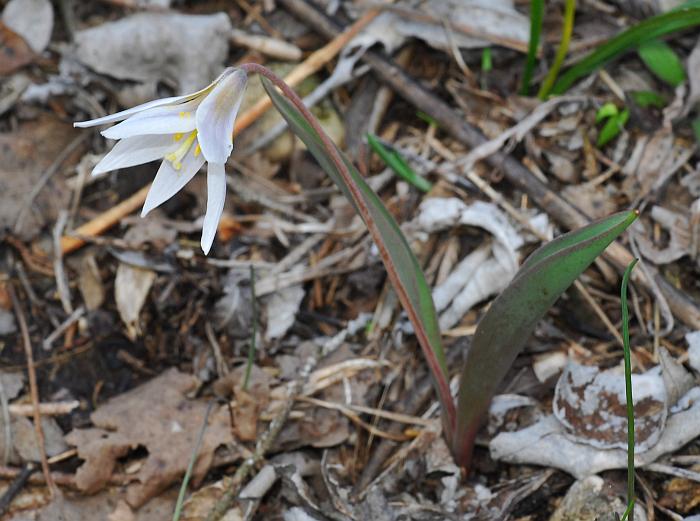Erythronium mesochoreum Knerr
Prairie Dogtooth Violet

Native
CC = 7
CW = 5
MOC = 40
© SRTurner
Erythronium mesochoreum KnerrPrairie Dogtooth Violet | |
 |
Native CC = 7 CW = 5 MOC = 40 |
© SRTurner |
|
Family - Liliaceae Habit - Perennial forb from a deep, bulblike corm. Stems - Ascending to erect, 10-20 cm long, unbranched, glabrous. Leaves - Leaves 2, alternate, arising from subterranean stem and thus appearing basal, bases tapering into a sheath. Blades 0.5-2.0 cm wide, linear-lanceolate to narrowly elliptic, somewhat folded longitudinally, sparsely or not mottled. Extensive "thousand leaf" array of sterile single leaves usually absent.
Inflorescences - Flowers solitary at tips of aerial stems. Flowers - Perianth 15-50 mm long, broadly bell-shaped to spreading, white, sometimes slightly tinged with pink, purple, blue, or green, the sepals and petals free, lanceolate. Stamens 6, free. Style 1, somewhat thickened near the tip. Stigmas 3. Ovary superior, with 3 locules, each with 8-20 ovules.
Fruits - Obovate capsules, the tips broadly rounded, sometimes slightly indented or with a small apiculum at the very tip, positioned on the ground as the aerial stem becomes strongly arched after flowering.
Flowering - March - May. Habitat - Prairies, glades, upland forest, rocky open areas. Origin - Native to the U.S. Lookalikes - Erythronium albidum. Other info. - This species is less common in Missouri than the closely related E. albidum. It is found in many areas of the state but appears to be missing from the eastern Ozarks and Mississippi Lowlands. Its U.S. distribution is also fairly limited, being centered in eastern Missouri and western Kansas and restricted to a few of the surrounding states. Photographs taken at Shaw Nature Reserve, Franklin County, MO, 3-28-2011 and 4-3-2019 (SRTurner). |